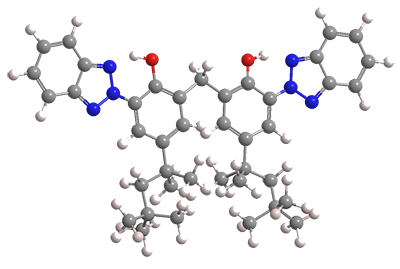What molecule am I?


The two benzotriazole groups in bisoctrizole make it an ideal substance for absorbing ultraviolet radiation. Thus, it is produced by BASF (Ludwigshafen, Germany) and MPI Chemie (Houten, The Netherlands) as an additive for sunscreen formulations.
Most compounds used in sunscreens are dissolved in the organic or aqueous phase of the product. But bisoctrizole is almost insoluble in anything, so it is prepared in microfine particles that are suspended in the aqueous phase.
Bisoctrizole is approved for use in the European Union and elsewhere, but not in the United States. The reason is that the manufacturers of bisoctrizole and other sunscreen ingredients are in a stalemate with the US Food and Drug Administration. FDA has requested additional toxicity data for the products to comply with current regulations, but the producers, citing the cost of testing, have asked FDA to relax the standards. As of January 2018, the situation had not been resolved.
Bisoctrizole hazard information
| GHS classification*: hazardous to the aquatic environment, acute hazard, category 3 | |
| H402—Harmful to aquatic life | |
| GHS classification: chronic aquatic toxicity, category 4 | |
| H413—May cause long-lasting harmful effects to aquatic life | |
*Globally Harmonized System of Classification and Labeling of Chemicals. Explanation of pictograms.
Bisoctrizole fast facts
| CAS Reg. No. | 103597-45-1 |
| Molar mass | 658.88 g/mol |
| Empirical formula | C41H50N6O2 |
| Appearance | White powder |
| Melting point | 197–200 °C |
| Water solubility | Insoluble |

Learn more about this molecule from CAS, the most authoritative and comprehensive source for chemical information.
Molecule of the Week needs your suggestions!
If your favorite molecule is not in our archive, please send us a message. The molecule can be notable for its current or historical importance or for any quirky reason. Thank you!
Stay Ahead of the Chemistry Curve
Learn how ACS can help you stay ahead in the world of chemistry.

